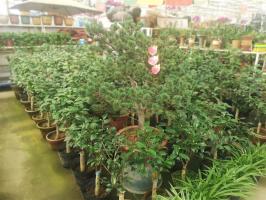How to Save a Moldy Soil in a Potted Plant
It's common for potted plants to develop moldy soil, especially if they're not getting enough sunlight, overwatered, or the soil is not draining properly. This can be harmful to the plant's growth and development, and may even cause it to die. However, there are several ways you can save your plant's moldy soil and get it back to good health.
Remove the Moldy Soil
The first step in saving a moldy soil in a potted plant is to remove the top layer of the soil where the mold is growing. You can use a spoon, trowel or your hands to scoop out the affected soil. Be careful not to damage the plant's roots or stem in the process. Dispose of the moldy soil in the trash and not in the compost pile to prevent it from spreading to other plants.
Aerate the Soil
After removing the moldy soil, it's important to aerate the remaining soil to improve drainage and allow air to circulate. You can use a fork to gently loosen the soil or add perlite, sand or vermiculite to the remaining soil to improve drainage. This will also help to prevent the soil from becoming waterlogged, which can lead to mold growth.
Adjust Watering Habits
One of the leading causes of moldy soil in potted plants is overwatering. To prevent mold growth, it's important to adjust your watering habits. Always check the soil moisture level before watering, and only water when the soil is dry to the touch. Also, make sure the pot has proper drainage holes to allow excess water to drain off. You can also add a layer of gravel or rocks at the bottom of the pot to improve drainage.
Add Beneficial Fungi and Bacteria
Another way to save a moldy soil in a potted plant is to add beneficial fungi and bacteria to the soil. These microorganisms can help to break down organic matter in the soil, improve nutrient uptake, and prevent mold growth. You can buy soil inoculants or compost tea from a garden center or make your own by steeping compost in water for several days.
Use Natural Fungicides
If the mold growth is severe, you may need to use natural fungicides to kill off the mold. Some natural fungicides include neem oil, cinnamon, baking soda, and hydrogen peroxide. Make a solution of the fungicide and spray it on the soil and the plant's leaves, being careful not to saturate the soil. Repeat the process every few days until the mold is gone.
Conclusion
In conclusion, moldy soil in a potted plant can be a sign of improper watering, poor drainage, or lack of sunlight. To save your plant's moldy soil, remove the affected soil, aerate the remaining soil, adjust your watering habits, add beneficial fungi and bacteria, and use natural fungicides if necessary. With proper care, your potted plant will thrive and remain healthy and vibrant for years to come.

 how many times do yo...
how many times do yo... how many planted tre...
how many planted tre... how many pine trees ...
how many pine trees ... how many pecan trees...
how many pecan trees... how many plants comp...
how many plants comp... how many plants can ...
how many plants can ... how many plants and ...
how many plants and ... how many pepper plan...
how many pepper plan...
































